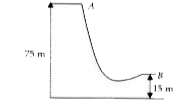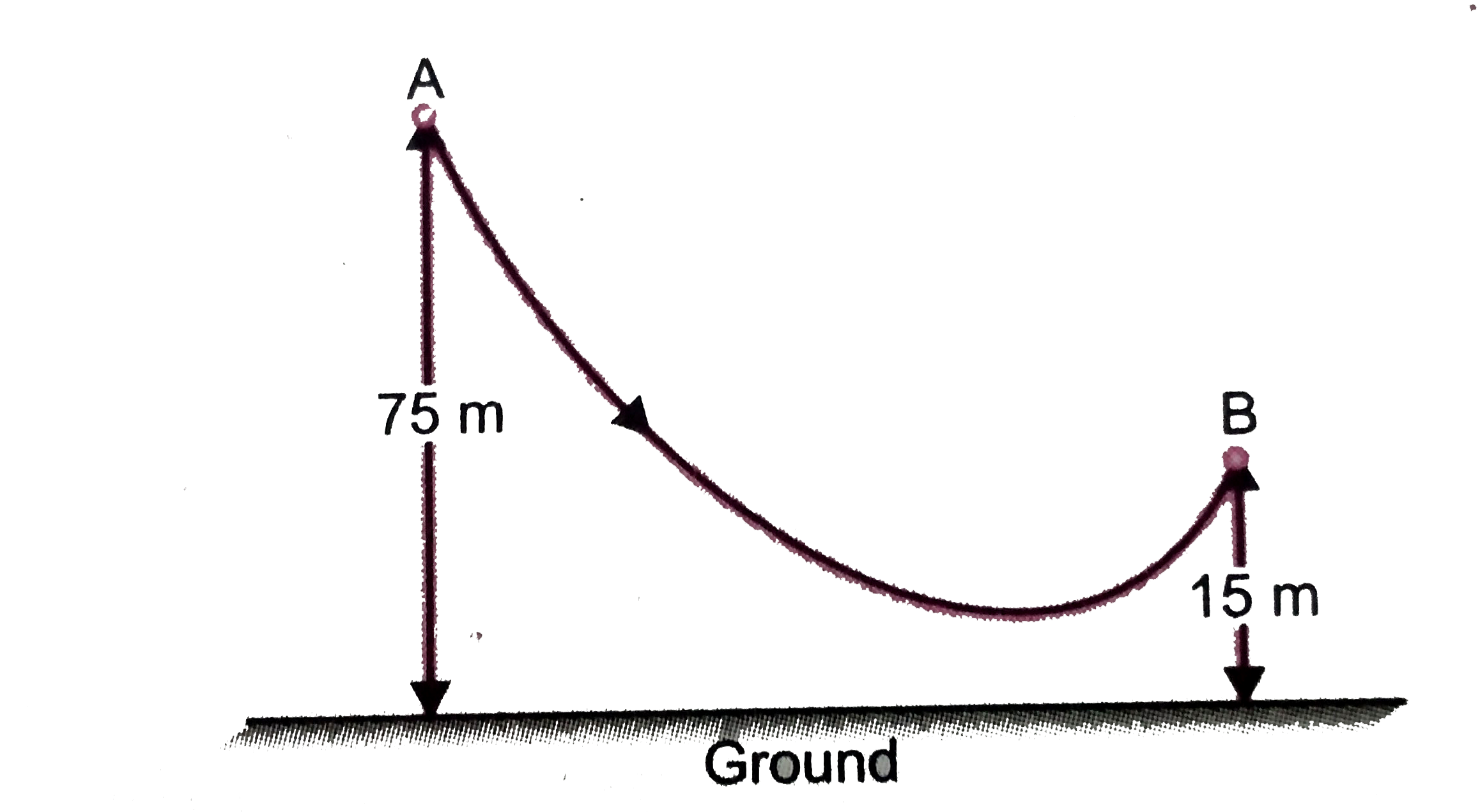The diagram shows a ski jump. A skier weighing 60kg f stands at A. He moves from A to B and takes off for his jump at B

Calculate the change in the gravitational potential energy of the skier between A and B.
Change in gravitational potential energy
Topper's Solved these Questions
- WORK AND ENERGYBOOK - MTG IIT JEE FOUNDATIONCHAPTER - WORK AND ENERGYEXERCISE - Exercise (Long Answer Type)
17 Videos
- WORK AND ENERGYBOOK - MTG IIT JEE FOUNDATIONCHAPTER - WORK AND ENERGYEXERCISE - Exercise (Integer/Numerical Value Type)
5 Videos
- WORK AND ENERGYBOOK - MTG IIT JEE FOUNDATIONCHAPTER - WORK AND ENERGYEXERCISE - Exercise (Subjective Problems Very short Answer Type)
16 Videos
- THRUST AND PRESSUREBOOK - MTG IIT JEE FOUNDATIONCHAPTER - THRUST AND PRESSUREEXERCISE - Olympiad/HOTS Corner
15 Videos
Similar Questions
Then diagram given below shows a ski jump.A skier weighing 60 kgf stands at A at top of ski jump.He moves from A and takes off for his jump at B.

(a)Calculate the change in the gravitational potential energy of the skier between A and B.
(b)If 75 % of the energy in part (a)becomes kinetic energy at B,calculate the speed at which the skier arrives at B.
(Take g=10 m s−2)
View Solutionshows a ski -jump. A skier of mass 60 kg stands at A at the top of the ski-jump. He moves from A to B and takes off for his jump at B.
(a) Calculate the change in the gravitational potential energy of the skier between A and B.
(b) If 75 % of the energy in part (a) becomes the kinetic energy at B, calculate the speed at which the skier arrives at B.
View Solution
Knowledge Check
A particle of mass m is moved from A to B as show in figure. Then potential energy of the the particle
 Awill continuously increasesBwill continuously decreasesCwill first increase and then become constantDwill first decreases and then become constant
Awill continuously increasesBwill continuously decreasesCwill first increase and then become constantDwill first decreases and then become constant
The gravitational field in a certain region is given as
→E=(3Nkg−1)ˆi+(5Nkg−1)ˆj
(a) What will be magnitude of gravitational force acting on a particle of mass 3 g which is placed at the origin ?
(b) What will be gravitational potential at point (12m, 0) and (0, 6m) considering that potential at origin is zero ?
(c ) A particle of mass 3 kg is moved from the origin to the point (9m, 4m). Calculate the change of gravitational potential energy.
(d) If the above particle is moved from (5m, 0) to (0, 5m), then find the change in potential energy.
View SolutionIn deep space, sphere A of mass 20 kg is located at the origin of an x axis and sphere B of mass 10 kg is located on the axis at x = 0.95 m. Sphere B is released from rest while sphere A is held at the origin. (a) What is the gravitational potential energy of the two-sphere system just as B is released? (b) What is the kinetic energy of B when it has moved 0.15 m toward A?
View SolutionA particle of charge 1 μC is moving from point A that is at potential 100 V to point B that is at potential 500 V. Calculate the change in kinetic energy of the charged particle.
View SolutionA particle of mass 3 kg takes 2 second to move from point A to B under the action of gravity and another constant force →F=(12ˆi−3ˆj+12ˆk)N, where the unit vector ˆk is in the direction of upward vertical. The position vector of point B is →rB=(15ˆi−7ˆj−6ˆk)m and velocity of the particle when it reaches B is →VB=(12ˆi+ˆj−4ˆkm/s.
(a) Find the velocity, →VAof the particle when it was at A.
(b) Find position vector, →rA of point A
(c) Find work done by the force →F as the particle moves from A to B
(d) Find change in gravitational potential energy of the particle is it moves from A to B
View SolutionThe gravitational field in a region is given by →E=(5Nkg−1)→i+(12Nkg−1)→j.. a. find the magnitude of the gravitational force acting on a particle of mass 2 kg placed at the origin b. Find the potential at the points (12m,0) and (0,5m) if the potential at the origin is taken to be zero. c. Find the change in gravitational potential energy if a particle of mass 2 kg is taken from the origin to the point (12m,5m). d. Find the change in potential energy if the particle is taken from (12m,0) to (0,5m).
View SolutionA particle of mass m is moved from A to B as show in figure. Then potential energy of the the particle

View SolutionA boy weighing 25 kgf climbs up from the first floor al a height of 3 m above the ground to the thind floor al a height of 9 m above the ground. What will be the increase in his gravitational potential energy? (Take g = 10 N kg−1)
View Solution
